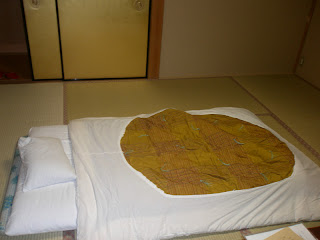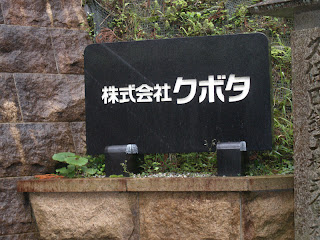(If you want to see Steven's way better pictures, you should click here.)
(...why is this highlighted?)
So I headed over to Kyoto on Friday, met up with Steven and Michele, and grabbed really good Thai curry for dinner! (I may be way too into curry.) Afterwards I crashed at Steven's apartment on his really nice spare futon.
Saturday, Steven and I woke up Really Early to begin our wild adventure to Mt. Koya! We took a train to a train to a train to another train to the same train (...we had to move to a different car halfway through the journey, because it turned out that only half the cars were going to Koya) to a cable car to a bus! Phew. It took about 3 1/2 hours to get to Mt. Koya, at which point we discovered that it was POURING RAIN. Yaaaaaaaaaay. Also, the wind was blowing all the raindrops under our umbrellas. GREAT.
Anyway, our first stop was Kongoubuji, also known as the head temple of the Shingon sect of Buddhism! We bought our Mt. Koya pass there, which was 2,000 yen and let us into a bunch of different temples/museums/other random things in the area. We were joking that Mt. Koya is like Buddhism Disneyland, and our pass was like a park hopper ticket. (Also, I was definitely waiting for some of the priests who were showing us around to tell us, "Keep your hands and arms inside the vehicle at all times, and, please, watch your children.")
Anyway, Kongoubuji!
It was very wet.
But it had nice rock gardens.
And some nice wood carvings.
Oh, and rooms that depicted the life and journeys of Kuukai (the founder of Shingon Buddhism in Japan). But we couldn't take pictures of those.
There were also some spectacularly awkward translations of signs, which accidentally killed the parents of everyone reading them.*
It was raining pretty hard, as you can probably tell!
DRAGONS.
MUD.
Looking out from the main gate!
More wood carvings!
Here's the other side of the gate.
...I don't even know.
Stop idling, you guys.
Also, I think that's a monkey, a pig, and a kappa????
So then we went over to a different building (the Daishi Kyoukai) to receive jukai, which is actually a pleonasm, because "jukai" means "receive the precepts," but apparently the people who made all the English-language materials didn't really care about that! Anyway, the precepts are the ten laypeople's Buddhist precepts, which are, in order:
1. I will not kill or harm any living beings.
2. I will not take what is not given to me.
3. I will not engage in harmful sexual conduct.
4. I will not lie.
5. I will not speak improperly.
6. I will not speak harshly.
7. I will not speak divisively.
8. I will not be covetous.
9. I will not have ill will.
10. I will not hold wrong views.
(At least, that's how the bilingual pamphlet we were given translates them.**)
Anybody can do jukai, regardless of their professed religion, so we got to sit in on a short ceremony and repeat the precepts and a couple of mantras, and Steven discovered the joys of powdered incense (which you put on your hands so your hands smell like cinnamon for the rest of the day).
...I think I have already broken some of the precepts, because I definitely beat a cockroach to death with a frying pan, and unless it was a zombie cockroach, that probably breaks #1.
OOPS.
Anyway, we then went over to the Houreikan, which is a big museum of artifacts from Mt. Koya. And since Kongoubuji is roughly 1200 years old, there are a lot of artifacts! We got to see some Buddhist statues with ATTITUDE and some really old calligraphy and some interestingly shaped rocks, because apparently some people at Mt. Koya are as into interestingly shaped rocks as I am!
By the time we got out of the museum, pretty much everything else on Mt. Koya was closed, so we headed over to Henjoukouin, where we were doing our temple stay! A temple stay is literally spending the night at a temple, which was pretty cool.
This was the view of the garden from my room.
FUTON.
Garden, again.
...because why not?
GARDEN.
(There were frogs in the pond. They woke me up at 3 a.m. It was exciting.)
These little cranes were scattered throughout the room.
Anyway, we got dinner and breakfast included in our temple stay. Because it was a temple, everything was vegetarian (and I think everything might have been vegan as well, but I'm not entirely sure), which means that I had no idea what I was eating. But it was all delicious, so all was well.
There was also a morning service at 6:30 that everyone doing the temple stay was invited to, but I woke up at 6:21 and decided that I probably couldn't get ready in 9 minutes, so I wound up skipping it. Steven went, though, and said it was interesting.
Anyway, after breakfast we headed out for more adventures.
This, by the way, is the main gate of Henjoukouin, where we were staying.
Aaaaand here's the front.
It had (thankfully) stopped pouring rain, although it was SUPER FOGGY.
Our first stop of the day was Okunoin, which is Kuukai's mausoleum/temple*** surrounded by a huuuuuuuuuge graveyard.
There was also a cool tree.
Their hand-washing station was kind of lacking in majesty, though.
This is a Navy memorial.
LOOK AT THESE STAIRS.
THESE STAIRS ARE DRUNK.
There's a lot of Sanskrit on Mt. Koya, which made an interesting change.
COMPLETELY INEBRIATED STAIRS.
There was a question about the bibs a million years back, which I think I forgot to answer. The bibs are offerings from visitors to the shrine/temple, and they're tied around statues of deities/spirits to give them comfort. Sort of like giving them a coat! Some people will write their names and addresses on the bibs as well.
Some of these people also wrote the things they were wishing for.
I am pretty sure this is a mizuko memorial, because they appear to be holding fetuses.
(I see dead babies EVERYWHERE.)
More Sanskrit!
It looks so INTERESTING.
...well, this is apparently a grave for Subaru.
Yes, the car company.
TREE.
...and this is a grave for Panasonic.
...and this is one for Kubota.
Um.
...and this is a fugu.
It is a grave to perform services for fugu.
The grave is owned by a restaurant, which, presumably, serves fugu.
Let's take a second to think about this.
THIS IS A FUGU.
Oh, hey, we finally made it to the temple!
(That little guy to the right of the entrance is the mascot of Mt. Koya.)
(There he is again.)
These people were pouring water onto statues of various Buddhist deities.
Unfortunately, we weren't allowed to take any pictures near the mausoleum, but there was this amazing room that was filled with rows and rows and rows of lanterns. Definitely one of the most beautiful things I have ever seen.
Here, have a picture of a waterfall instead.
(These are the statues from before.)
Temple for the glorious war dead!
Yes, that is a rocket.
So then we decided to hike alllllllllll the way to the other end of Mt. Koya, to see the daimon (literally "big gate").
Did I mention that it was foggy?
This is the best possible bench.
FOG.
SO MUCH FOG.
It's weird, but my camera could "see" more of the fog than I could.
So that was the Daimon!
Then we headed over to a cluster of small temples called the Daigaran on the way back...
This is the Daitou, or the "giant pagoda."
So that was that!
We then picked up some omiyage (well, I picked up omiyage and Steven picked up a really nice copy of the heart sutra), wandered around the mountain a bit more, and stumbled upon this temple:
It was a temple for temple stays, so it wasn't terribly big.
But it did have an interesting pagoda!
So, yeah! Then we headed back toward the station, but on the way we stopped at the Tokugawa Mausoleum.
The actual shrines were behind these fences, which made it difficult to make pictures.
But I took sneaky pictures through the fence.
And then we headed over to where female pilgrims used to stay when women weren't allowed up the mountain (because they would defile everything with their femaleness; no, I am not making this up).
The name of the temple is literally "lady person hall," which is what Steven and I were calling it, because we are mature people.
There was also this Buddha across the road.
Anyway, then we took the bus back to the station to catch the...
Cable car! (Not pictured: Cable car. Pictured: Scary stairs to the cable car station.)
And then we took a train to a train to a train to a train, and we met Michele and one of her friends for dinner, and had the best tonkatsu of our LIVES.
And then Steven and I headed back to his place and crashed!
And then we woke up!
And then I headed back to Nagoya!
And then I beat a cockroach to death with a frying pan!
And then everyone freaked out over a pretty weak typhoon!
THE END.
*Basically, the sign in Japanese said "the cry of the mourning dove reminds the listener of his/her natsukashii parents," where "natsukashii" means "causing nostalgia" or "nostalgic," sort of? (I guess "invoking strong emotions because of past associations"?) And the English sign said "the cry of the mourning dove reminds the listener of his/her dearly departed parents," which is NOT THE SAME AT ALL.
**I have my own translation based off of the Japanese, which is...um...less majestic sounding. For example, "I will not speak harshly" is literally "no bad mouth." And "I will not speak divisively" is literally "no double tongue." And "I will not engage in harmful sexual conduct" is either "no evil sex" or "no evil semen." HMMMMMM.
***Kuukai isn't actually believed to be dead; he's supposedly in "eternal meditation."











































































































